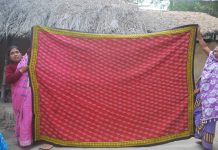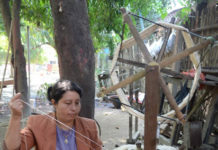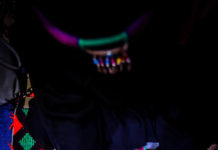
Ulos is a traditional woven cloth from Batak ethnic group in Toba Highland, North Sumatera, Indonesia. In the most literal sense, ulos can be translated as “blanket”. Ulos plays a significant role in Batak society, as it closely ties to their adat or customary laws and essential in ceremonial context. Traditionally, ulos is made from cotton yarns using back strap loom. Ulos Batak Toba is considered an Indonesian woven textile that utilises the widest range of techniques. There are many types of ulos, and each ulos has its own intrinsic meaning and specific uses ranging from everyday use to highly symbolic gifts.

There are many types of ulos. The most important types are: Ulos Ragidup, Ragihotang, Harungguan, Bintang Maratur, Sibolang, Sitolutuho and Sadum. Arguably, the most sacred Ulos is Ragiidup (pattern of life). It consists of five panels: three panels in the middle, in between two side panels. Ends of the middle part called pinar halak (depiction of human): one side is pinar halak baoa that represents male, and the other side is pinar halak boru that represents female. These two ends are connected by centerfield that consists of stripe pattern.
The most distinguish technique that specific to this Ulos called manuluki (some weavers named the technique maraput). Although pinar halak consists of two parts, the weaving process is done with one continuous warp. Manuluki technique is used to connect pinar halak to the centerfield stripe pattern, while still in its original warp, without cutting or sewing. The pinar halak warp is layered with the stripe centerfield warp, and inserted with some weft yarns to lock both parts.
Besides manuluki, some techniques used in ulos weaving are: warp ikat, jugia (supplementary warp), jungkit (supplementary weft), twining, and beading weft. One ulos usually consists of many different techniques. Ulos is warp-faced weaving, although ulos like sadum may used both warp-faced and weft-faced in one cloth.
One particular weaver that excels in ulos ragidup is Inang (Mrs.) Hutagalung, Boru Simatupang in Desa Hutagalung, Tarutung, North Sumatra. Both of her and her daughter are master weavers. Inang Hutagalung usually weaves the pinar halak and the centerfield, while her daughter weaves the two side parts. Ulos could be found until this day in any marketplace in Toba Highland, as Batak Toba people are still using it until now. Although the functionality of the Ulos as a body protection had been replaced by modern clothing, the symbolism still remains. Nowadays Batak people usually wear it as a draping in their shoulder in special adat ceremony.




